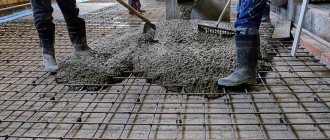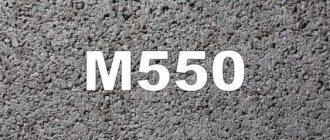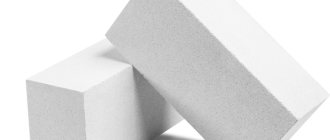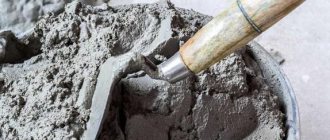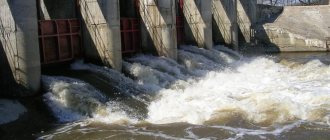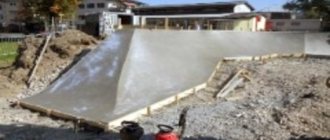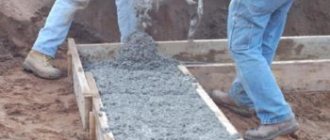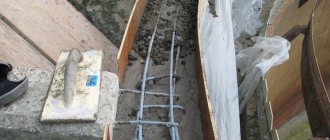Concrete 100 is widely used when carrying out a wide range of repair work. This material does not require the use of special tools or devices. To lay concrete M 100 you do not need to put in a lot of effort; the material fits well into any shape. The building material has little resistance to load influences, for this reason it is used for minor stages. For example, preparatory work before the construction of the foundation; it will serve as a concrete pad that creates a barrier for cement laitance and will protect the lower parts of the reinforcement frame from corrosion.
Composition of concrete M 100
In order to obtain high-quality concrete, the manufacturing technology must be strictly followed. Lean concrete M 100 includes a minimal amount of cement, which serves to hold the aggregate together. It is also recommended to adhere to the general recommendations for the component and proportional part. In many ways, the composition of the mixture will depend on its purpose and compliance with the future design. Concrete grade M 100 will contain less cement compared to a higher grade. It is recommended to select the components that make up the concrete mixture, guided by practice-tested recipes and current standards. According to the norms and requirements of building regulations, the mixture is prepared using the following components:
- Portland cement, various brands of cement powders are used, which will serve as binding components for all the ingredients of the mixture;
- washed river sand and sand-gravel mixture;
- crushed stone, fillers based on limestone and the middle fraction of granite or gravel chips are also used;
- The dry mixture is poured with water and mixed well.
Approximate composition of concrete M 100 per 1 m3:
- water 0.23 m3;
- sand 0.58 m3;
- crushed stone 0.8 m3;
- cement M 400 250 kilograms.
When asked how much cement is in concrete m100. You can answer that 1 m3 includes 200-250 kg of dry component.
Special substances are added to the M 100 concrete solution that affect the performance of the building material.
Concrete in Ufa
Concrete as a building material
Concrete is the basis of all construction. It is this material that is used to fill foundations of various types, ranging from monolithic slabs to strip and columnar structures.
It is necessary to distinguish between terms. The word "concrete" means a hardened concrete solution, which consists of cement, crushed sand and water, mixed in special proportions.
Often the concrete solution is called “ready-mixed concrete”. Such concrete is prepared in a factory in compliance with technologies, recipes and often has various additives (plasticizers, hardening retarders or antifreeze additives for winter conditions). The strength grade of such concrete is guaranteed by the manufacturer. Ready-mixed concrete is produced under strict control and is constantly tested to ensure compliance the strength declared by the manufacturer in a special laboratory.
On our portal there are large and reliable suppliers of concrete ()
will offer to buy concrete with delivery to various areas of the city of Ufa and throughout the Republic of Bashkortostan .
You will be offered the lowest price for ready-mixed concrete of various grades, produced in modern concrete plants.
High-speed organized by the company from the plant closest will preserve the strength of the concrete solution, thanks to the minimum delivery distance.
Transportation costs are reduced to 9,000 rubles . We recommend saving money for other expenses. It is better to order concrete mortar of any brand directly from the factory.
You can make concrete yourself if you have all the components and know the proportions of the concrete brand you need. For better quality concrete production, you cannot do without a compact concrete mixer and a vibrator for compacting the mixture.
How to make concrete with your own hands
Individual housing construction (IHC), especially in the economy class, has its own characteristics. Many people, having purchased building plots, do most of the construction work themselves, often during the summer holidays.
With ready-made trenches and a poured base , for example, for a strip foundation, two people slowly make wooden formwork and install a reinforcing belt. They don’t need a ready-mixed concrete mixer; even 1 cubic meter of concrete mixture from the factory is a lot. After all, it needs to be laid quickly and correctly.
Life suggested the right option for independent gradual concreting of foundations. Inert materials are delivered to the site: crushed stone of the required fractions and washed sand. Water and cement reserves are being created .
A small concrete mixer, which can be rented, is charged in the required proportion with inert materials, cement and water.
While the formwork is being installed or reinforcement , all components are mixed and a concrete solution is formed. This process requires some control.
Then the finished concrete solution is poured into a stretcher and poured into the finished part of the formwork with reinforcement.
Next comes compaction of the concrete. This is how the foundation of a country house is laid layer by layer.
However, this super economical method is fraught with many pitfalls and dangers.
A primitive concrete mixer is not a factory unit or even a car mixer. It is not able to provide a uniform mixture of concrete components.
This heterogeneity in the composition of the concrete solution greatly affects its quality and strength development after pouring. Heavy fractions end up at the bottom, water and cement laitance occupy the surface layers.
With uneven hardening, stresses arise, which are relieved in the form of cracks. This is how marriage is born when the foundation is poured using primitive means.
Daily layer-by-layer pouring of the foundation with small portions of concrete leads to the absence of a monolithic structure. Each portion of concrete has some differences from the previous batch, even if the proportions are observed.
Unnecessary seams are formed between layers.
Not all people can have a construction education and understand the quality and fractional composition of the same crushed stone.
As for sand, instead of it you can purchase sandy loam with clay inclusions. Of great importance for the strength of a concrete foundation is the quality of cement, its actual brand, production technology, manufacturer, shelf life (after 6 months of storage, cement loses 30% of its strength properties) and much more.
Laying and compaction alone (with deep and surface vibrators) cannot produce a high-quality
Freshly poured concrete needs appropriate care , at least for a period of 2 weeks, until half of its strength gains. This care is different at different times of the year.
It is necessary to soberly assess the level of your knowledge and skills in construction before making concrete.
Concrete proportions
Correctly selected proportions of concrete allow, having high-quality inert materials, cement and water, to obtain a concrete solution of the appropriate grade strength. The purchase of inert materials, and especially cement, must be approached with special care. You need to beware of any fraudulent suppliers and low, “ thieves’” prices . It is better to purchase these materials from a reputable company that can be responsible for the quality of building materials.
So for the most common (in pouring monolithic foundations of private low-rise buildings , cottages and mansions) grade of concrete “200”, it is necessary:
RECIPE No. 1 (from M400 cement)
- for 1 part of M400 cement add 2.8 parts of sand and 4.8 parts of crushed stone,
size 35 mm.,
- or enriched sand and gravel mixture (SGS), with a gravel content of 20% and a particle size of 20-40 mm.
RECIPE No. 2 (from M500 cement)
To prepare concrete grade 200 from M500 cement :
- it is necessary to mix cement grade 500, sand and crushed stone in proportions 1: 3.5: 5.6. In this case, there will be more ready-made concrete mortar. The crushed stone should be made from limestone fraction 35.
- or enriched sand and gravel mixture (SGS), with a gravel content of 20% and a particle size of 20-40 mm.
These are volumetric proportions in buckets , shovels, etc.
To prepare high-quality concrete solutions, your own proportions are required. When mixing concrete, water is added in parts.
The usual proportion of cement and water is 1: 0.7. The resulting concrete should be thick , this prevents the formation of cracks in it.
Concrete from the manufacturer
Self-production of concrete has a number of undeniable advantages associated with technologies for the budget construction of foundations for country houses. And yet you need to think and estimate the real costs and risks .
As an alternative, you need to take a closer look at the real benefits of directly ordering ready-mixed concrete from the manufacturer .
First of all, this is a guarantee of quality and declared brand strength . There is simply no stale cement at concrete plants; all its reserves immediately go into production.
Ordering fresh, freshly made concrete mortar is a guarantee of the strength of your foundation and a guarantee of its quality.
By ordering concrete in Ufa from a reputable building materials supplier, you will get real benefits . Fast delivery of the solution will be made from closest in distance to your facility, and you will have the opportunity not only to save money on transportation ( 5-7 thousand rubles is not the limit !), but also to receive a free consultation from a specialist technologist. All clients are offered high-quality ready-mixed concrete with strength M200-M800. Its quality is confirmed by many years of application practice and relevant documents (passports and test reports).
Pros and cons of DIY concrete
| Criteria | With your own hands | Concrete from the manufacturer |
| Foundation cost | 5-7% cheaper | |
| Homogeneous mixture (uniform mixing of components) | 60-80% | 100 % |
| Filling speed | 1-2 days | 1-5 hours |
| Specialist consultation | ||
| Guarantee and quality certificate | ||
| Compliance with the grade of ready-made concrete | 70-90% | 100 % |
| The resulting concrete grades in practice | M100, M150, M200 | M100, M150, M200, M250, M300, M350, M400, M450, M500 |
| Pouring under the concrete pump (in any hard-to-reach areas) |
Specifications
Concrete M 100 has a certificate of conformity, which has the following performance characteristics:
- Density qualities vary from 2.37 t/cub.m to 2.4 t/cub.m. The indicators depend on the dimensions of the filler used.
- Low strength, the material is able to withstand loads that amount to 0.098 tons/sq.cm of surface area;
- Frost resistance, where F50-F100 indicators indicate the absence of crack formation on a monolithic surface from 50 to 100 freezing cycles.
- Quality of mobility. Concrete solutions have good elasticity and compaction, especially grades P2-P4.
- Waterproof qualities correspond to level W2-W4. This feature creates a protective barrier that prevents the loss of cement laitance.
- The hardness indicators are Zh2-Zh4. This material retains its shape when poured, which makes the work process easier.
The quality of frost resistance and water resistance depends on the size of the filling material. Granite, gravel, expanded clay or limestone fillers are used, which affects the performance indicators.
Concrete M 100, what kind of building material is it? Interpretation of concrete M 100: the letter “M” means grade, and 100 means strength indicators. This solution belongs to concrete class B 7.5 according to the strength characteristics of SNiP. The letter “B” denotes a number that is responsible for the value of the guaranteed strength of a concrete product in compression and axial tension in MPa, with a probability of 95%.
The specific gravity of compositions based on various fillers will also differ:
- a mixture based on expanded clay granules and shell rock will be 0.5-1.8 tons. This material belongs to lightweight construction mixtures;
- 1 m3 of heavy mortar includes gravel or crushed stone with a coarse fraction and weighs 1.8-2.3 tons;
- the specific gravity of especially heavy compositions has metallic inclusions, the weight is 3 tons.
Data that characterizes the density of the concrete mixture is used in calculations. For the construction sector, other indicators are used - the volumetric mass of grade M 100 is 1.84 tons.
Features of lean concrete
- Lightweight concrete refers to concrete with increased rigidity.
The rigidity of concrete is a characteristic of its ability to spread, filling a standard form. The higher it is, the less plastic the composition. Because of this feature, very light grades - up to M100 - are not used in private construction, since laying them without special equipment is not easy. But when laying asphalt, due to its slow fluidity, such concrete is easier to work with a roller.
The hardness of concrete is designated by the letter Z. As a rule, for lean concrete it is 4 units.
- It has low (compared to other brands) strength.
But what does low mean in this case? The composition is not suitable for a dam or column, and only it is used as the bottom layer of the road surface. - Frost resistance from F50 to F100.
The numbers indicate the number of guaranteed freezing and thawing cycles; in fact, they take longer. - Water resistance (indicated by the letter W and characterizes the ability of the material not to allow water to pass under pressure) for lean concrete is average W4–W8. For comparison: other compositions may have the designation W2.
- Finally, it's easy to make yourself, especially if you have a concrete mixer. Most often, mixtures M100, M150, M200 are diluted for private construction.
It is impossible to say unequivocally that one characteristic reflects the advantages of a product, while another speaks of disadvantages. It's all about the areas of application:
- in road construction - for road bases;
- as bottom slabs and bases of foundations;
- when pouring floor screed;
- for the construction of decorative paths.
That is, in almost all cases, another, more dense layer is applied on top of the lean concrete.
Lightweight concrete in road construction
Proportions for manufacturing
When making concrete mortar, special attention should be paid to the exact parts of the ingredients. Experts recommend taking cement grades M 400 and M 500. For example, for the ratio of the constituent elements, take one part of M 400 cement and 4.6 parts of sand and 7 crushed stone.
When the M 500 grade of cement mortar is used, then the proportional number will look like this: 1 to 5.8 to 8. In the description of the M 100 concrete standards, the amount of water is not indicated. It is recommended to add water until the mass becomes plastic; a very liquid mixture is not permissible.
When large volumes of concrete mixture are produced, it is better to use a concrete mortar mixer. To do this, place dry ingredients in a container, mix, and then add water, then mix again until a homogeneous mass is formed. Next, to obtain the desired consistency of the solution, add the rest of the water.
The volumetric weight of concrete M 100 will depend on the proportions of the filler and the amount of water spent, the presence of voids and the quality of the batch. At enterprises, concrete mixtures M 100 are produced according to GOST 7473-94 standards (concrete mixtures).
M150
Class according to GOST: BST V12.5 P4 F50 W2 Concrete mixture grade M150 can be safely called one of the most popular materials in construction. It is especially popular among private developers, since it almost completely covers their needs - from laying out the foundation to creating partitions, walls and other structures. Price: 3300 ₽
Concrete production
Concrete mortar is prepared from available ingredients; this mixture will be indispensable when performing various construction stages. Manufacturing technology must be followed using the highest quality components. Concrete grade M 100 contains the following filler options:
- gravel;
- crushed limestone with a fraction from 5 to 20 mm;
- granite fillers;
- There is no need to add stabilizers and modifiers.
Option for obtaining 1 m3 of solution
To do this you will need the following materials and tools:
- capacity;
- bucket;
- shovel;
- hoe;
- 200 kg of cement;
- 750 kg of sand;
- 1200 kg of crushed stone;
- water 180 l.
All building materials are poured into a container and mixed well with a hoe. First add 10 liters of water and mix again, then gradually pour in all the water. There is another kneading method. First, water is poured in, and then mixed with cement, then with sand.
Compound
Portland cement is used for the binding properties of M100 concrete, then fillers are added to the composition - in the form of sand, crushed stone or medium-sized gravel, and lastly water - to create the desired consistency. The choice of components differs depending on the specific tasks assigned.
| Cement brand | Mass composition: cement: sand: crushed stone, kg | Volume composition: cement: sand: crushed stone, l | Amount of concrete from 10 liters. cement, l |
| M400 | 1:4,6:7 | 1:4,1:6,1 | 78 |
| M500 | 1:5,8:8,1 | 1:5,3:7,1 | 90 |
The volume of water is selected in accordance with the required thickness of the mixture.
If you use M500 cement as the base, the percentage of fillers in the composition is higher than with M400 cement. The volume of the resulting solution also differs.
Where is it used?
Concrete M 100, can withstand light loads, where is it used? The purposes of using the material are as follows:
- during preparatory work during pouring of the foundation;
- formation of underlying bases for road surfaces;
- for fixing curbs;
- construction of platforms for installation of reinforced concrete elements;
- concrete M 100 is often used during rough work in non-residential buildings, where pouring is carried out directly onto the soil;
- when concreting floors in basements and cellars;
- landscaping;
- interior decoration.
The specific use of the solution involves laying it in a thin layer on the surface layer of soil or compacted sand cushion. If necessary, the mixture is strengthened with iron reinforcement, which increases its strength qualities. The main characteristics of concrete M 100 must be indicated in the quality certificate. Therefore, you should carefully study the accompanying documents that confirm the quality. Concrete M 100 B 7.5 is used in special cases where serious performance qualities are not required, and the emphasis is on the low cost of the product.
Despite the low strength indicators, M 100 concrete is popular among consumers, for which it is used as described above. In addition, you can point out that pouring the mixture will not require much effort. After the material hardens, a reliable base will be formed that will retain its strength for a long time.
It is strictly not recommended to use class B 7.5 concrete, which is also called “skinny”, in structures prone to high loads. This type is intended for use when laying reinforced concrete elements.
Scope of application
Concrete grade M100 has low resistance to loads, so it is used only in work where they are insignificant. For example, in preparatory work before pouring the foundation, it acts as a concrete pad, which creates a barrier for cement laitance, protecting the lower layer of reinforcement from corrosion.
You can’t do without it on roads either: pour it in a thin layer no more than 10 cm thick on a bed of sand, wait for it to harden and install the reinforcement. This is how sidewalks, pedestrian paths, curbs, fences, and small pillars are made. It is also necessary for equipping different types of sites: parking lots, stops. This type of concrete has found its application even in agriculture: in places where concreting needs to be done directly on the ground (cellar, barn) for laying a “rough” floor.
Class B7.5 is called “skinny” and is used in the manufacture of reinforced concrete blocks, which in the future will not be subject to strong pressure.
Return to contents
Advantages and disadvantages
Lightweight concrete grade 100 has the following advantages:
- The affordable cost of the building mixture significantly reduces costs.
- The reliability of the solution allows you to maintain the integrity of the finished surface when exposed to negative natural phenomena.
- The durability of concrete marking M 100 is due to technical and strength indicators that do not lose their properties for a long time. The specific gravity of concrete M 100 is approximately 2.494 tons per 1 m3.
- The mortar is safe; the raw materials included in the composition are environmentally friendly and do not have a negative impact on human health.
- Concrete M 100 is available and has excellent technical characteristics.
- Moisture resistance - the solution is not subject to destruction when exposed to a humid environment and is able to reliably protect reinforcement from corrosion.
- Wide range of applications - from road construction to house construction.
- Frost resistance - the material can withstand up to 50 stages of freezing and thawing. This type of solution can be used in any climatic conditions of our country.
The main positive feature of this brand of concrete is its moisture resistance and excellent interaction with the soil; this quality allows you to fill paths in gardens and parks, install fence posts, and carry out various preparatory work that involves direct contact with the soil cover.
Minuses
The main disadvantage of the concrete mixture is the low strength of the building material after hardening. After any base has been prepared, reinforcement is laid on the top layer of concrete screed M 100, and then further work is carried out with a mixture of a higher grade. With many positive qualities, lean concrete has the following disadvantages:
- there is a risk of crack formation that impairs the performance and integrity of the element;
- the strength characteristics are reduced; this feature does not allow the use of building materials for important work related to concreting.
To increase strength and reduce the risk of deformation, when preparing a concrete solution, emulsions based on bitumen are added to the composition.
M200
Class according to GOST: BST V15 P4 F100 W4 Concrete marked M200 is widely used in construction. This is due to its high technical characteristics, which allow the building material to be used to solve a wide range of problems. Among the advantages of the mixture of this marking, it is worth noting the ideal combination of price and quality. Price: 3400 ₽


